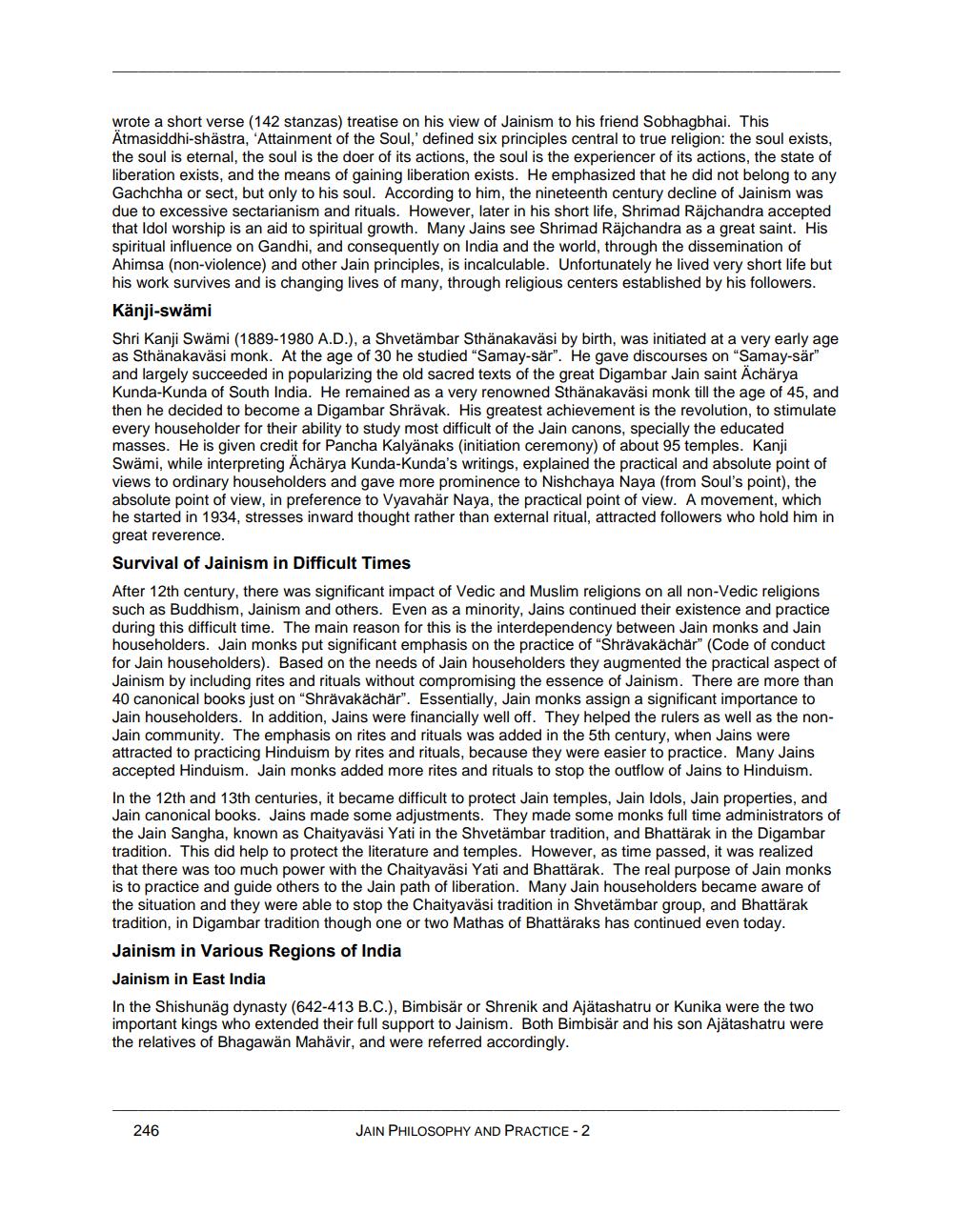________________
wrote a short verse (142 stanzas) treatise on his view of Jainism to his friend Sobhagbhai. This Ätmasiddhi-shästra, 'Attainment of the Soul,' defined six principles central to true religion: the soul exists, the soul is eternal, the soul is the doer of its actions, the soul is the experiencer of its actions, the state of liberation exists, and the means of gaining liberation exists. He emphasized that he did not belong to any Gachchha or sect, but only to his soul. According to him, the nineteenth century decline of Jainism was due to excessive sectarianism and rituals. However, later in his short life, Shrimad Räjchandra accepted that Idol worship is an aid to spiritual growth. Many Jains see Shrimad Räjchandra as a great saint. His spiritual influence on Gandhi, and consequently on India and the world, through the dissemination of Ahimsa (non-violence) and other Jain principles, is incalculable. Unfortunately he lived very short life but his work survives and is changing lives of many, through religious centers established by his followers. Känji-swämi
Shri Kanji Swami (1889-1980 A.D.), a Shvetämbar Sthänakaväsi by birth, was initiated at a very early age as Sthänakaväsi monk. At the age of 30 he studied "Samay-sär". He gave discourses on "Samay-sär" and largely succeeded in popularizing the old sacred texts of the great Digambar Jain saint Ächärya Kunda-Kunda of South India. He remained as a very renowned Sthänakaväsi monk till the age of 45, and then he decided to become a Digambar Shrävak. His greatest achievement is the revolution, to stimulate every householder for their ability to study most difficult of the Jain canons, specially the educated masses. He is given credit for Pancha Kalyanaks (initiation ceremony) of about 95 temples. Kanji Swämi, while interpreting Ächärya Kunda-Kunda's writings, explained the practical and absolute point of views to ordinary householders and gave more prominence to Nishchaya Naya (from Soul's point), the absolute point of view, in preference to Vyavahär Naya, the practical point of view. A movement, which he started in 1934, stresses inward thought rather than external ritual, attracted followers who hold him in great reverence.
Survival of Jainism in Difficult Times
After 12th century, there was significant impact of Vedic and Muslim religions on all non-Vedic religions such as Buddhism, Jainism and others. Even as a minority, Jains continued their existence and practice during this difficult time. The main reason for this is the interdependency between Jain monks and Jain householders. Jain monks put significant emphasis on the practice of "Shrävakächär" (Code of conduct for Jain householders). Based on the needs of Jain householders they augmented the practical aspect of Jainism by including rites and rituals without compromising the essence of Jainism. There are more than 40 canonical books just on "Shrävakächär". Essentially, Jain monks assign a significant importance to Jain householders. In addition, Jains were financially well off. They helped the rulers as well as the nonJain community. The emphasis on rites and rituals was added in the 5th century, when Jains were attracted to practicing Hinduism by rites and rituals, because they were easier to practice. Many Jains accepted Hinduism. Jain monks added more rites and rituals to stop the outflow of Jains to Hinduism.
In the 12th and 13th centuries, it became difficult to protect Jain temples, Jain Idols, Jain properties, and Jain canonical books. Jains made some adjustments. They made some monks full time administrators of the Jain Sangha, known as Chaityaväsi Yati in the Shvetämbar tradition, and Bhattärak in the Digambar tradition. This did help to protect the literature and temples. However, as time passed, it was realized that there was too much power with the Chaityaväsi Yati and Bhattärak. The real purpose of Jain monks is to practice and guide others to the Jain path of liberation. Many Jain householders became aware of the situation and they were able to stop the Chaityaväsi tradition in Shvetämbar group, and Bhattarak tradition, in Digambar tradition though one or two Mathas of Bhattäraks has continued even today.
Jainism in Various Regions of India
Jainism in East India
In the Shishunäg dynasty (642-413 B.C.), Bimbisär or Shrenik and Ajätashatru or Kunika were the two important kings who extended their full support to Jainism. Both Bimbisär and his son Ajätashatru were the relatives of Bhagawän Mahävir, and were referred accordingly.
246
JAIN PHILOSOPHY AND PRACTICE - 2




